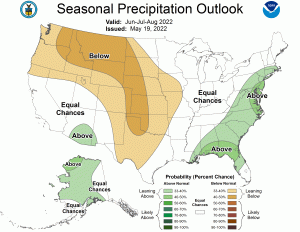
Update – Week of May 2 – Mosquito Treatments Begin; Helicopters are Active
May 5, 2022
Weekly Update – May 23rd – Adult Mosquitoes Begin Appearing in a Few Spots
May 31, 2022
Dipper full of mosquito larvae collected in Savage recently.
Results from the first adult mosquito and black fly surveillance of the year shows few mosquitoes are flying yet, black flies are starting to increase.
Every Monday night starting in mid-May through September, the Metropolitan Mosquito Control District sets out a variety of mosquito and black fly traps throughout the district and employs a network of sweep net collections done by employees and volunteers. Any insects collected are brought back to our lab on Tuesday to be identified throughout the week with maps published to show current mosquito and black fly activity.
Our first mosquito and black fly surveillance night of the year happened on Monday, May 16th when a combination of sweep net collections, CO2 traps, and other methods showed what we typically expect this time of year: even though our crews have been finding lots of mosquito larvae in ponds and wetlands, adult mosquito numbers are still low.
According to MMCD assistant entomologist Scott Larson, "We mostly collected spring Aedes species that have been hatching for some time now, some Aedes vexans that very recently emerged, and a few of the mosquitoes (Anopheles species and Culiseta inornata) that somehow manage to survive all winter as adults." Larson also stated that gravid traps found a fair number of Culex mosquitoes, another species that overwinters as adults by sheltering in caves or manmade structures.
May is typically when we begin to see an increase in biting gnats/black flies especially in areas close to rivers and streams. Black fly collections were what we would expect at this time of year, with a spots in Dakota and Carver counties reporting over 50 per trap, but most only catching a few. Our crews seek to reduce black fly annoyance by using a control material in rivers and streams that is designed to specifically target black fly larvae and nothing else. If you are noticing high numbers of adult black flies, please use our Submit a Tip form and let us know!
Here are the mosquito trap counts from last Monday, May 16th:
MMCD field staff have been busy completing air and ground treatments after recent rain and in permanent water sites.
There have been a few big rain events already this spring, which have given mosquito larvae the conditions to develop in ponds, wetlands, and man-made habitats like containers throughout the District. Over the past two weeks helicopters have been active almost every day and prior to today our crews treated a total of 54,611 acres of mosquito habitat by air. Helicopters will be back up throughout the District this week treating cattail mosquito habitat. Cattail mosquitoes (Coquillettidia perturbans) are a unique species that over-winters as larvae by attaching to the roots of pond vegetation (often cattails) and emerges once per year, around the beginning of July.
 The National Oceanic and Atmospheric Administration had previously predicted that our part of the country might see a drier year than usual, but after some recent May showers they have updated their prediction for summer precipitation to suggest we may have a normal year for rainfall in 2022. Mosquito larvae are out in abundance (see photo at the top of this post) and our field staff our working hard to reduce mosquitoes that may lead to disease and annoyance this summer.
The National Oceanic and Atmospheric Administration had previously predicted that our part of the country might see a drier year than usual, but after some recent May showers they have updated their prediction for summer precipitation to suggest we may have a normal year for rainfall in 2022. Mosquito larvae are out in abundance (see photo at the top of this post) and our field staff our working hard to reduce mosquitoes that may lead to disease and annoyance this summer.
Please help us out by reducing mosquito habitat on your property - check your yard after any rain to see if there is any standing water and eliminate it promptly.
Ticks are out in abundance - May is Lyme Disease Awareness Month!
It's a good reminder that while mosquitoes and other insects may not be abundant yet, ticks are active this time of year in Minnesota. Our field staff have been finding many ticks when out doing inspections and treatments for mosquitoes. Wood ticks ("American dog ticks") or deer ticks ("blacklegged ticks") are the most common in our area and the latter has the potential to transmit pathogens that cause Lyme disease. June is one of the peak months for Lyme transmission because nymph ticks are most active and their tiny size makes them hard to find.
Please be sure to check yourself, your kids, and your pets for ticks any time you are in a wooded area, long grasses, or any habitat that could be hospitable for insects. For more information on tickborne disease visit the Minnesota Department of Health website.
For the latest updates on mosquito control, disease activity, and planned treatments, follow MMCD on Twitter or Facebook.






